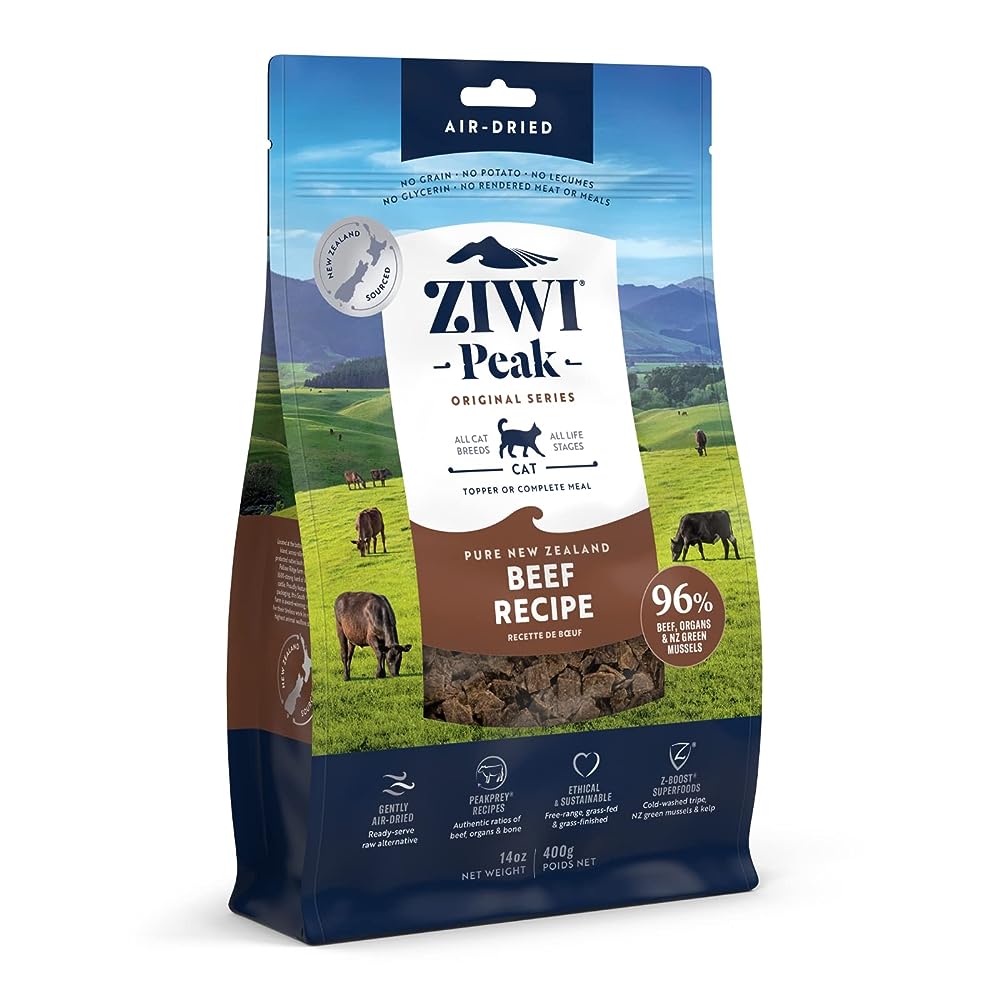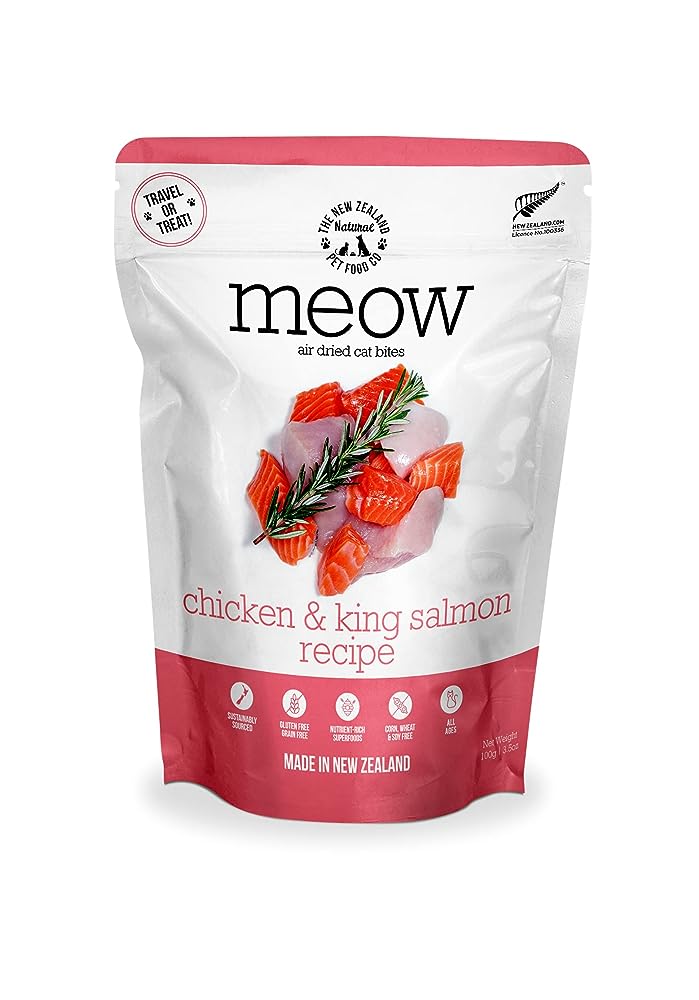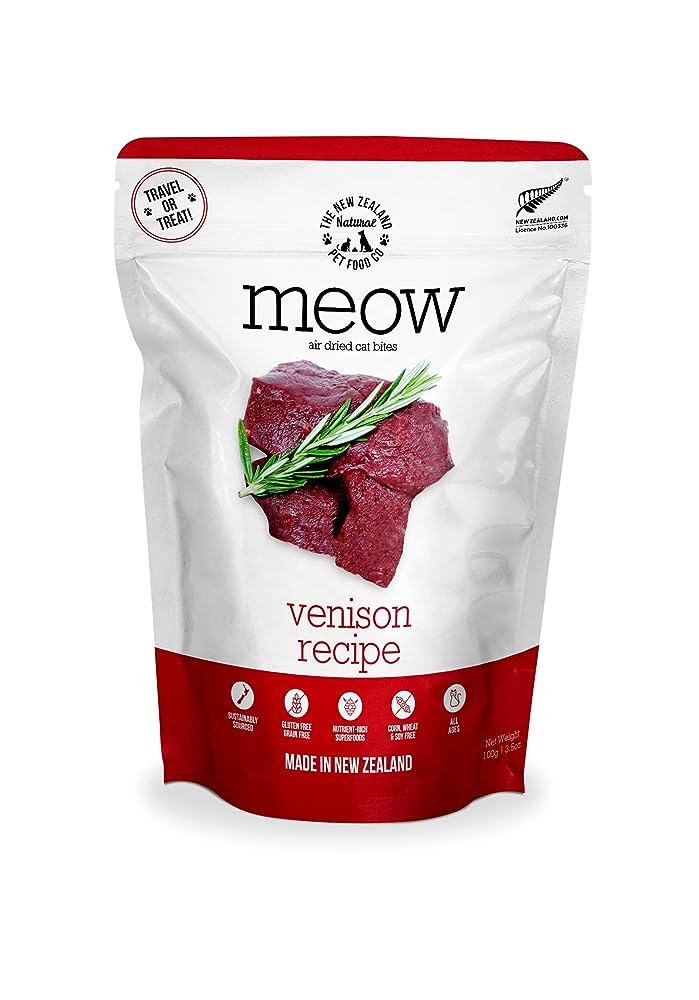In the vast world of feline nutrition, air-dried foods have emerged as a unique blend of convenience and optimal nourishment. Offering a middle ground between raw diets and conventional dry kibble, air-dried foods retain most of the nutrient content of raw ingredients without the need for artificial preservatives. As cat owners become increasingly discerning about their pets’ dietary needs, many are turning to air-dried options for their unparalleled quality and taste appeal.
#1 – ZIWI Peak Air-Dried Cat Food – All Natural, High Protein, Grain Free & Limited Ingredient with Superfoods (Chicken, 14 oz)
ZIWI Peak Air-Dried Cat Food is a high protein, grain-free, and limited ingredient cat food made with all-natural ingredients. It features whole-prey ratios, including 96% free-range chicken, organs, bone, and New Zealand green mussels, all safely air-dried to retain nutrition and taste. With added superfoods like poultry heart, New Zealand green mussels, and organic kelp, this cat food supports digestion, healthy weight, reduced shedding, joint health, and heart and brain health. It can be used as a topper or a complete meal for cats of all life stages.
Best For: Best overall.
#2 – ZIWI Peak Air-Dried Cat Food – All Natural, High Protein, Grain Free & Limited Ingredient with Superfoods (Lamb), 14 Ounce (Pack of 1)
The ZIWI Peak Air-Dried Cat Food is an all-natural, high protein, and grain-free cat food option. It includes authentic whole-prey ratios, with 96% free-range lamb and other nutritious ingredients like New Zealand Green Mussels. This cat food is suitable for cats with food sensitivities and can be used as a topper or a complete meal for all life stages.
Best For: Best overall
#3 – ZIWI Peak Air-Dried Cat Food – All Natural, High Protein, Grain Free & Limited Ingredient with Superfoods (Beef, 14 oz)
ZIWI Peak Air-Dried Cat Food is an all-natural, high protein, grain-free cat food made with limited ingredients and superfoods. It features 96% free-range beef, organs, bone, and New Zealand green mussels that are safely air-dried to retain their nutritional value and flavor. This cat food is ideal for food-sensitive cats and can be used as a topper or a complete meal for cats of all life stages.
Best For: Best ingredient sourcing.
#4 – Catit Gold Fern Premium Air-Dried Cat Food, Lamb & Mackerel, 14 oz
Catit Gold Fern Premium Air-Dried Cat Food is a high-quality cat food that is gently air dried to preserve all the nutrients of the raw ingredients. It has a high meat inclusion of 95% and is crafted to closely resemble a cat’s natural, whole-prey diet. The food includes superfoods like New Zealand green-lipped mussel and is sourced from ethically managed farms.
Best For: Best ingredient sourcing
#5 – Meow Chicken & Salmon Air Dried Travel/Treat Food 3.5oz
The Meow Chicken & Salmon Air Dried Travel/Treat Food is a 3.5oz product made with all-natural ingredients that contain no grain, gluten, artificial preservatives, flavors, or colors. It is a nutrient-rich superfood that can be used as a meal mixer or topper. Suitable for cats of all life stages.
Best For: Cats looking for a natural and nutritious treat.
#6 – The New Zealand Natural Pet Food Meow Venison Air Dried Food Travel/Treat 3.5oz
The New Zealand Natural Pet Food Meow Venison Air Dried Food is a 3.5oz travel-friendly treat for pets. It is made with all-natural ingredients and is free from artificial preservatives, flavors, colors, grain, and gluten. This nutrient-rich superfood can be used as a meal mixer or topper for pets of all life stages.
Best For: Pet owners looking for a travel-friendly and nutrient-rich treat for their pets. (best on a budget)
What Are The Benefits of Air Dried Foods for Cats?
Certainly! Air-dried foods for cats offer several advantages:
- Nutrient Retention: Unlike traditional cooking or canning processes, air-drying doesn’t involve high temperatures. This means that most of the natural nutrients in the ingredients are retained. Essential vitamins, minerals, and enzymes that might be lost during traditional cooking methods are preserved.
- High Protein Content: Air-dried cat foods are often rich in animal-based proteins because they primarily consist of meat and fish. This aligns with a cat’s natural dietary needs as obligate carnivores.
- Reduced Carbohydrates: Cats have limited dietary requirements for carbohydrates. Many air-dried foods focus on meat, reducing the carbohydrate content compared to some other types of cat food.
- Natural Preservation: The air-drying process naturally preserves the food, eliminating the need for artificial preservatives. This reduces the risk of feeding cats potentially harmful chemicals.
- Palatability: Many cats find air-dried foods more palatable and tasty due to the preservation of natural flavors.
- Convenience: Air-dried foods provide a convenient alternative to raw feeding. They are easier to store, handle, and serve than raw diets, while still giving many of the same nutritional benefits.
- Safety: The air-drying process can reduce the risk of bacterial contamination present in raw foods. While raw feeding has its proponents, it also comes with risks, especially if not handled or sourced correctly.
In conclusion, air-dried foods for cats can provide a balanced, nutrient-rich diet that aligns closely with their natural dietary needs. Always consult with a veterinarian when considering a significant change to your cat’s diet.
How Does Air Dried Cat Food Compared to Dry, Wet, or Freeze Dried Foods?
Certainly! Let’s break down the comparison of air-dried cat food to dry (kibble), wet, and freeze-dried foods:
- Air-dried Cat Food:
- Nutrient Retention: Air-drying gently evaporates moisture from the food without high heat, which helps preserve the nutrients, especially proteins and certain heat-sensitive vitamins.
- Texture and Moisture: It is a bit softer than traditional kibble but drier than wet food, making it easier for some cats to eat.
- Storage: It can be stored at room temperature but, once opened, should be used within a recommended time frame to ensure freshness.
- Dry Cat Food (Kibble):
- Processing: Typically extruded, which involves cooking the ingredients at high temperatures, potentially leading to a loss of some nutrients.
- Texture: Hard and crunchy, which can be beneficial for dental health.
- Storage: Can be stored for longer periods, and is resistant to spoilage once opened, but can become stale if left open for extended periods.
- Wet Cat Food:
- Moisture Content: Contains up to 80% moisture, which is beneficial for cats’ hydration, especially since cats are notoriously poor drinkers.
- Texture: Can vary from chunks in gravy to pate.
- Nutrient Density: Generally lower in carbohydrates than dry foods.
- Storage: Once opened, it should be refrigerated and consumed quickly.
- Freeze-dried Cat Food:
- Nutrient Retention: Freeze-drying involves removing moisture at very low temperatures, preserving almost all the natural nutrients.
- Texture: Light and crumbly but can be rehydrated with water to mimic the texture of fresh food.
- Safety: The freeze-drying process significantly reduces microbial content, making it safe for consumption.
- Storage: Can be stored for a long time but should be sealed properly to prevent moisture from re-entering.
In comparison:
- Air-dried food strikes a balance between the convenience of kibble and the nutrient preservation found in freeze-dried foods.
- It doesn’t provide the hydration benefits of wet food but retains more of the original flavor of the ingredients compared to kibble.
- For owners looking to maintain the nutrient quality similar to a raw diet without the hassle, both air-dried and freeze-dried foods are good options.
As always, when choosing the right type of food for your cat, consider factors like age, health condition, activity level, and personal preferences. It’s also beneficial to consult with a veterinarian to ensure that your cat’s specific nutritional needs are met.
Frequently Asked Questions About Air Dried Cat Foods
- What is air-dried cat food?
- Air-dried cat food is made by gently evaporating moisture from the food without using high heat, which helps to preserve the nutrients, especially proteins and certain vitamins. This results in a product that’s intermediate in moisture between kibble and wet food.
- How is air-dried food different from freeze-dried food?
- While both methods aim to remove moisture and preserve nutrients, air drying is a slow evaporation process, whereas freeze drying involves freezing the food and then removing the ice without it passing through the liquid phase.
- Is air-dried cat food safe from bacteria?
- Yes, the air-drying process reduces the moisture content to a level where harmful bacteria cannot thrive. However, it’s essential to store the food correctly to prevent contamination.
- Do I need to refrigerate air-dried cat food after opening?
- No, but you should store it in a cool, dry place and use it within the recommended time frame to ensure freshness.
- How long does air-dried cat food last once opened?
- The shelf life can vary depending on the brand, but once opened, most air-dried foods should be consumed within a month for optimum freshness.
- Can I mix air-dried food with other types of cat food?
- Yes, many cat owners mix air-dried food with kibble or wet food. Always ensure the total caloric intake is appropriate for your cat’s needs and adjust portions accordingly.
- Is air-dried food suitable for kittens and senior cats?
- Generally, yes, but it’s essential to choose a formula specifically designed for the life stage of your cat. Always consult with a veterinarian for personalized advice.
- Does air-dried cat food have grain or fillers?
- Air-dried foods typically prioritize high-quality protein sources and often avoid grains, but always check the ingredient list. Some may include vegetables, fruits, or other beneficial ingredients.
- Is air-dried cat food more expensive than other types?
- While air-dried cat food can be pricier than traditional kibble, it’s often more nutrient-dense. The cost may balance out when considering portion sizes and the benefits of a higher quality diet.
- Will a dental water additive change the taste of my dog’s water?
- Most dental water additives are formulated to be tasteless or have a mild flavor that most dogs don’t mind or even enjoy. If your dog seems hesitant to drink the water after adding the product, consider introducing it gradually or trying a different brand.
Conclusion: Best Air Dried Foods for Cats
Navigating the best options for your feline friend can feel overwhelming, but air-dried foods have unmistakably carved out a niche for those seeking both nutrition and convenience. While it’s always essential to consult with a veterinarian when making significant changes to your cat’s diet, it’s clear that air-dried foods offer a promising alternative for those aiming for a more natural and nutrient-dense feeding solution. The journey to feline health is ever-evolving, and it’s heartening to see options that bring us closer to nature’s intent.






